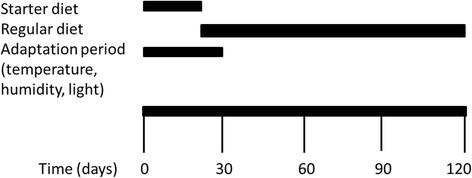Biological mechanisms discriminating growth rate and adult body weight phenotypes in two Chinese indigenous chicken breeds
- PMID: 28633640
- PMCID: PMC5477733
- DOI: 10.1186/s12864-017-3845-9
Biological mechanisms discriminating growth rate and adult body weight phenotypes in two Chinese indigenous chicken breeds
Abstract
Background: Intensive selection has resulted in increased growth rates and muscularity in broiler chickens, in addition to adverse effects, including delayed organ development, sudden death syndrome, and altered metabolic rates. The biological mechanisms underlying selection responses remain largely unknown. Non-artificially-selected indigenous Chinese chicken breeds display a wide variety of phenotypes, including differential growth rate, body weight, and muscularity. The Wuding chicken breed is a fast growing large chicken breed, and the Daweishan mini chicken breed is a slow growing small chicken breed. Together they form an ideal model system to study the biological mechanisms underlying broiler chicken selection responses in a natural system. The objective of this study was to study the biological mechanisms underlying differential phenotypes between the two breeds in muscle and liver tissues, and relate these to the growth rate and body development phenotypes of the two breeds.
Results: The muscle tissue in the Wuding breed showed higher expression of muscle development genes than muscle tissue in the Daweishan chicken breed. This expression was accompanied by higher expression of acute inflammatory response genes in Wuding chicken than in Daweishan chicken. The muscle tissue of the Daweishan mini chicken breed showed higher expression of genes involved in several metabolic mechanisms including endoplasmic reticulum, protein and lipid metabolism, energy metabolism, as well as specific immune traits than in the Wuding chicken. The liver tissue showed fewer differences between the two breeds. Genes displaying higher expression in the Wuding breed than in the Daweishan breed were not associated with a specific gene network or biological mechanism. Genes highly expressed in the Daweishan mini chicken breed compared to the Wuding breed were enriched for protein metabolism, ABC receptors, signal transduction, and IL6-related mechanisms.
Conclusions: We conclude that faster growth rates and larger body size are related to increased expression of genes involved in muscle development and immune response in muscle, while slower growth rates and smaller body size are related to increased general cellular metabolism. The liver of the Daweishan breed displayed increased expression of metabolic genes.
Keywords: Biological mechanisms; Breast muscle; Chicken ( Gallus gallus) breeds; Growth rate; Liver; Metabolic differences; Microarray.
Figures





References
Publication types
MeSH terms
LinkOut - more resources
Full Text Sources
Other Literature Sources
Medical

